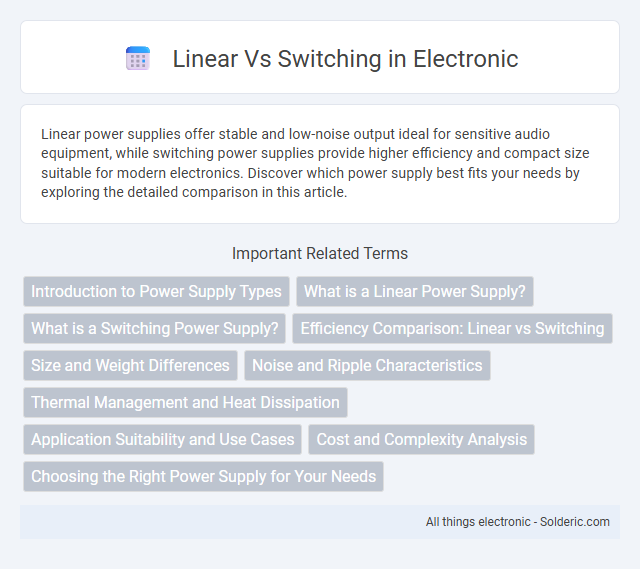Linear power supplies offer stable and low-noise output ideal for sensitive audio equipment, while switching power supplies provide higher efficiency and compact size suitable for modern electronics. Discover which power supply best fits your needs by exploring the detailed comparison in this article.
Comparison Table
| Feature | Linear Regulator | Switching Regulator |
|---|---|---|
| Efficiency | Low (typically 40-60%) | High (80-95%) |
| Output Noise | Low, clean output | Higher noise, requires filtering |
| Complexity | Simple design | Complex circuit with inductors and capacitors |
| Size | Larger heat sinks needed | Compact due to high efficiency |
| Cost | Lower cost | Higher cost due to components |
| Applications | Low noise, low power devices | High power, battery-powered systems |
| Heat Dissipation | High heat generation | Minimal heat generation |
| Voltage Conversion | Only steps down voltage | Steps up, down or invert voltage |
Introduction to Power Supply Types
Linear power supplies regulate voltage by dissipating excess power as heat through a series pass transistor, providing low noise and stable output ideal for audio and sensitive analog circuits. Switching power supplies convert electrical energy using high-frequency switching components and inductors or transformers, achieving higher efficiency and smaller size, suitable for modern digital devices. Choosing between linear and switching depends on application requirements like efficiency, noise sensitivity, and size constraints.
What is a Linear Power Supply?
A linear power supply uses a transformer to step down voltage, followed by a rectifier and regulator to provide a stable, low-noise output. These supplies are known for their simplicity, reliable performance, and minimal electrical noise, making them ideal for sensitive audio and measurement equipment. Your choice of a linear power supply ensures steady current delivery but typically involves larger size and lower efficiency compared to switching power supplies.
What is a Switching Power Supply?
A switching power supply converts electrical power efficiently by rapidly switching a transistor on and off, regulating voltage through high-frequency transformers and inductors. Unlike linear power supplies that dissipate excess energy as heat, switching supplies minimize energy loss, making them ideal for compact, high-performance applications. Your choice of a switching power supply ensures better efficiency and heat management in electronic devices.
Efficiency Comparison: Linear vs Switching
Switching power supplies typically achieve efficiency rates between 80% and 95%, significantly outperforming linear regulators, which usually range from 40% to 60%. The higher efficiency in switching regulators results from their ability to minimize power dissipation by rapidly switching on and off, reducing wasted energy as heat. Linear regulators, in contrast, operate by dissipating excess voltage as heat, limiting their efficiency especially in applications with large voltage differentials.
Size and Weight Differences
Linear power supplies are significantly larger and heavier due to their bulky transformers and heat sinks designed to dissipate excess heat efficiently. Switching power supplies utilize high-frequency transformers and smaller components, resulting in a compact, lightweight design ideal for portable and space-constrained applications. The reduced size and weight of switching power supplies provide enhanced efficiency and versatility compared to traditional linear models.
Noise and Ripple Characteristics
Linear power supplies exhibit low noise and ripple characteristics due to their simple design and continuous regulation, making them ideal for noise-sensitive applications such as audio and precision instrumentation. Switching power supplies generate higher noise and ripple because they use high-frequency switching elements, which introduce electromagnetic interference (EMI) and switching harmonics that require complex filtering. Advanced filtering techniques, including LC filters and spread spectrum modulation, are essential in switching supplies to minimize ripple and electromagnetic noise for improved performance in sensitive electronic devices.
Thermal Management and Heat Dissipation
Linear regulators generate more heat due to voltage drop across the pass transistor, making thermal management critical in designs with high input-to-output voltage differences. Switching regulators operate with higher efficiency by rapidly switching components on and off, significantly reducing heat dissipation and often requiring smaller heat sinks or less aggressive thermal solutions. Your choice depends on balancing heat generation against efficiency requirements and available space for cooling components.
Application Suitability and Use Cases
Linear power supplies provide low noise and excellent regulation, making them ideal for sensitive audio equipment, medical devices, and precision instruments where signal integrity is crucial. Switching power supplies excel in efficiency and power density, suiting applications such as computers, telecommunications, and battery-powered devices that demand compact size and high energy conversion. The choice depends on balancing the need for clean output voltage against efficiency and form factor constraints in the target application.
Cost and Complexity Analysis
Linear power supplies offer simpler design and lower initial cost due to fewer components, making them ideal for low-power applications with minimal noise sensitivity. Switching power supplies provide higher efficiency and reduced size but come with increased complexity and higher upfront costs due to advanced circuitry and electromagnetic interference management. Your choice depends on balancing budget constraints against performance and complexity requirements in your specific application.
Choosing the Right Power Supply for Your Needs
Linear power supplies offer stable, low-noise output, ideal for sensitive audio or laboratory equipment, while switching power supplies provide higher efficiency, compact size, and better heat dissipation suited for consumer electronics or industrial applications. Consider the application's voltage regulation requirements, energy efficiency, and physical space constraints when choosing between linear and switching power supplies. Evaluating factors like electromagnetic interference tolerance and cost-effectiveness ensures optimal performance tailored to your specific power needs.
Linear vs Switching Infographic

 solderic.com
solderic.com